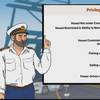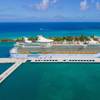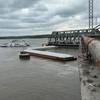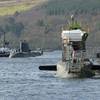The development of high-temperature superconductor (HTS) motors for the United States Navy's future all-electric ships has completed a significant milestone: the Navy's initial tests of its 5-MW, 230 rpm concept demonstrator have been satisfactorily completed. The motor, developed by American Superconductor Corporation (AMSC) under a contract with the Office of Naval Research(ONR), validates the potential of HTS technology to reduce the size and weight of marine propulsion motors as well as improve their efficiency in both military and commercial marine propulsion applications. AMSC manufactured the HTS rotor system integrated with a cryogenic refrigeration system. ALSTOM Power Conversion (ALSTOM) designed and manufactured the stator, marine drive electronics and performed the initial factory testing of the HTS motor and drive system.
During the Navy's testing program at the Center for Advanced Power Systems (CAPS) at Florida State University, the 5-MW motor successfully completed a comprehensive series of tests, which included an extended full power run and a dynamic simulation of loads the motor could experience on a ship at sea. Additional testing is planned to take place at the Naval Surface Warfare Center, Carderock Division (NSWCCD) in Philadelphia, Pennsylvania.
An important aspect of the Navy's new results obtained at CAPS is the confirmation of AMSC's proprietary electromagnetic, mechanical and thermal analytical models for HTS ship propulsion motors - a vital step in the development cycle for advanced electrical machines being designed by the Navy and for commercial use. Through this confirmation, AMSC will be able to expand its development model to include the even more powerful ship propulsion motors which are required for larger naval and commercial marine ships. A 36.5-MW HTS ship propulsion motor is expected to be delivered to the Navy in 2006 after all planned factory tests have been conducted. Load testing demonstrates how a motor performs under representative stresses and operating conditions it undergoes when powering a ship at sea. The final development stage of the motor provides engineers and ship propulsion integrators with vital information regarding design options and the operating characteristics of the new superconductor motors.
The 5-MW motor had previously undergone factory IEEE-115 no-load and partial load tests (full torque at half speed, and full speed at half torque) prior to delivery to the Navy. CAPS repeated and confirmed, under Navy test supervision provided by NSWCCD, all of these tests with the following results:
CAPS operated the motor at full load (5MW) and at full speed (230 rpm) for a total of 21 hours to confirm that the motor achieved steady-state temperature both in the rotor and in the stator. The actual temperatures measured correlated closely to results predicted by AMSC for the machine.
To simulate operation of the motor in an at-sea environment up to Sea State 5 (simulating a moderately strong sea), the CAPS testing imposed an increasing scale of 0.5% to 10% in torque modulations on the motor. The test results confirmed that the motor should perform as designed in representative sea states.
To complete the test program at CAPS, the testing team performed "hardware-in-the-loop" simulation tests. In this test phase, direct control of the motor system emulated the way the motor, drive, and entire ship's integrated power system (IPS) should respond during transient operation (i.e., speed variations).
The cumulative positive test results achieve yet another important benchmark in the development of HTS rotating machinery, and provide important validation that the follow-on ONR Program, in which a 36.5-MW (49,000 hp), 120 rpm HTS motor currently being built by AMSC and Northrop Grumman will be delivered to the Navy in the summer of 2006. This larger motor, sized for the Navy's future DD(X) ship, benefits from the successes achieved in the earlier ONR 5-MW development program. AMSC and Northrop Grumman have already successfully completed the first two phases of the three phase development process with successful preliminary design and detailed design reviews. The third phase, which is currently in progress, is the actual fabrication, factory acceptance testing, and delivery of the motor to the Navy.
HTS motors use rotor coils wound with HTS wires that can conduct more than 150 times the electric current of copper wires of the same dimensions, with no resistance. This enables the production of motor components that can deliver a higher power density resulting in ultra-compact motors, measuring as little as one-third the weight and one-half the size of copper-based motors of the same power and torque rating. The increase in power density can bring improvements in design options, such as the ability for ships to carry more fuel and payload, or have a smaller displacement while possessing equivalent capabilities to the larger and more costly alternative ship designs. In addition, HTS motors can operate with higher fuel efficiency and can have lower maintenance costs as compared to their conventional copper counterparts. These advantages are expected to be provided at a cost equivalent to conventional motors of the same power and torque.
Sponsored Content
Safer Starts Here: Build Ships, Protect Crews

Featured videos

Cat Pushes Forward on Hybrid Electric Solutions, Alternative Fuels

Corn Belt Ports Streamlines Critical Agriculture River Shipments

“One Man, One Wrench” Launched a Global Maritime Power Play
Subscribe for
Maritime Reporter E-News
Maritime Reporter E-News is the maritime industry's largest circulation and most authoritative ENews Service, delivered to your Email five times per week









